Revelations on Revelation (Part VII Section 1)
In a book club meeting a few years back, my friend Rachel mentioned how after her father’s cat, Popcorn, passed away, her three-year-old twin nephews, whose parents were very religious, kept repeating, “Popcorn died on the cross.”
Because of how they were taught about their parents’ faith, it seems like the boys understood the concept of Jesus dying by crucifixion before they understood the concept of death in general—which is a good reminder that religious beliefs can impact not only children’s experience but also their cognitive development.
That said, even without a strong religious influence, I got some things about death wrong when I first learned about it too.
As a child I used to tell my parents stories about a family of pigs. In one story I told my mom that the pigs ate dying people, at which point she interrupted, since it was a teachable moment, and said that you didn’t feed dying people to pigs. I asked what else you did with them, and she responded that you had them over and gave them a cup of tea, which left me very confused.

Eventually we determined that I had confused “dying” with “decomposing” and I had taken what I had learned about reducing, reusing, and recycling to a place many people wouldn’t.
But now let’s get back to what you’re here for, the dispensationalist apocalypse, which is made up of more than just wild beasts.
And lo! After a feature film worth of reading time, and my taking several months away from this project to focus on other aspects of my life, we’re finally at the part where I try to tie everything together.
I know I said there was only one post left, but I’ve now accepted that it’s going to end up longer than all the rest of them put together. Of course, I could just cut a bunch of stuff out and try to summarize what’s left but it’s my party and I’ll go on a deep dive into Biblical literalism (and also cry, because I’m doing a deep dive into Biblical literalism) if I want to.
So I’m going to split the post up, both to keep it readable and so that I can publish some of it now. But for the sake of sticking with all the sevens in Revelation, per my friend Matt’s suggestion, it’s going to take the form of Part VII, Sections 1–7.
In Part VII as a whole, I’ll look at how evangelical dispensationalists see contemporary events in the context of their beliefs on the End Times—and what they are trying to accomplish as a result.
Which means I finally get to discuss how these beliefs affect the risk of nuclear war, in the Middle East and elsewhere.

In Section 1, I’ll explore contemporary prophecy, introducing the hugely influential 1970 book The Late Great Planet Earth by Hal Lindsey along with Todd Strandberg’s prophetic event tracker website Rapture Ready.
Over Sections 3–6, I’ll tackle the main focus of Part VII: which events dispensationalists see as signs of the End Times, what they are doing as a result, and what they predict is going to happen next.
Then in Section 7, I will share a final judgement, as it were, on what I’ve covered in this whole series…and then it’ll all be over.
Table of Contents
The Late Great Planet Earth
In line with the massive audience of the A Thief in the Night film series, Hal Lindsey’s The Late Great Planet Earth was the best-selling nonfiction book of the decade according to the New York Times, with 10 million copies sold between its publication in 1970 and the end of 1979. This is both impressive and also a significant category error.
The cover of the 2016 e-book edition that I read says “over 15 million copies sold,” but it must just be an old design because it has at the very least doubled that by now, with 35 million copies sold by 1999.

There was even a 1977 documentary film adaptation featuring Orson Welles as the narrator, made during his wine commercial period, during which Welles was evidently wasted a lot of the time. Someone uploaded the whole movie to YouTube but I have only watched the trailer so far.
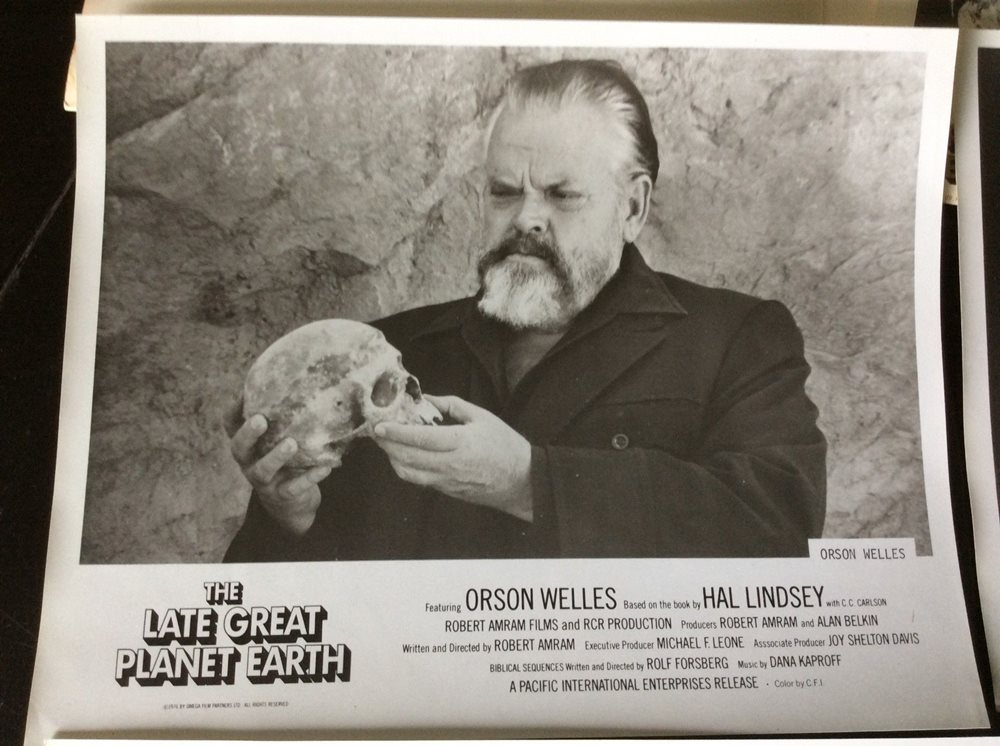
I did manage to read the entire book, however, and I also read a widely cited 2012 history MA thesis on LGPE (as I will refer to the book going forward) by Cortney Basham, who is now a professor at Western Kentucky University. It is full of useful analysis and also a number of quotes that are straight 🔥, which I will sprinkle throughout—kind of like all the times that fire rains down from the sky in Revelation.
Lindsey and his influences
By the time The Late Great Planet Earth was released in 1970, Harold Lee “Hal” Lindsey was a 40-year-old former Mississippi tugboat captain who had found Christianity in his late 20s, attended Dallas Theological Seminary, and then become a preacher for Campus Crusade for Christ.

CCC is still around and has a presence on Canadian university campuses, but it’s now called Cru, which en français is an adjective applied to light that is brutal, violent, and blinding.
Cru had a heavy presence under its former name at Carleton University when I attended in 2005–2010 but I didn’t know what branch of Christianity it represented at the time.
But now, even if I wasn’t aware of the connection between evangelicalism and the word “crusade,” based on the website of the subgroup the Carleton contingent belongs to—Power2Change (P2C)—it clearly fits right into this discussion.
In what may come as a relief to you after making it through the previous six posts, LGPE doesn’t contain any major theological departures from dispensationalist teachings at the time. As many people have identified, both believers and not, it is mostly a repackaging of Lindsey’s lecture notes from his graduate degree at seminary school.
Among others, Lindsey studied the work of John Nelson Darby, who I have talked about before, and Cyrus Scofield, whose 1909 Reference Bible was at the time unique in featuring annotations alongside the sacred text.
The format of the Reference Bible led many readers to give Scofield’s dispensationalist interpretations as much weight as the Bible itself, which their faith told them was the word of God and without error (“inerrant”)—something I’ll discuss again in the Interpreting the Bible portion.
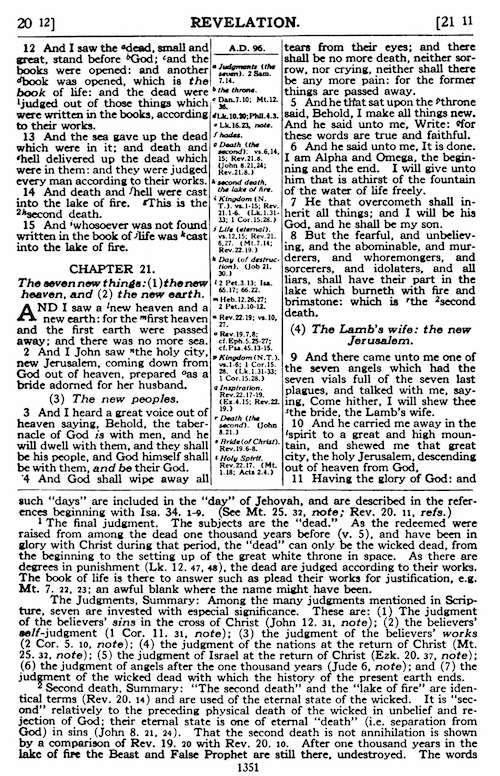
Scofield’s Reference Bible continued to be popular for decades after its initial publication, having sold at least 10 million copies by the time LGPE was released. 1
What LGPE does differently from other dispensationalist books exploring prophesy is apply it to events of the present day in a voice intended to appeal to a mass audience.
One way the book tries to accomplish this is by co-opting terms initially associated with the 1960s counterculture, despite being very much counter-counterculture.
For instance, Lindsey calls the rapture “The Ultimate Trip” while taking a fervently anti-drug position: drugs are connected to demonic possession, of course, which I’ll get to when I talk about perceived trends sweeping the youth of America as signs of the End Times.
The book also leansheavily into sensationalism. The writing style actually reminds me of the fictional Hollywood scandal magazine Hush-Hush in James Ellroy’s LA Quartet and Underworld USA novel series, which itself is based on the real-life 1950s Confidential magazine.

Although that approach is present throughout, especially in the slavering anticipation of bad things happening to people, the best example for me was Lindsey using the chapter titles “The Future Fuehrer” and “Rome on the Revival Road.” The alliteration is a hallmark of both Ellroy’s fictional tabloid (“carcinogenic Commie cocktails”) and its inspiration (“‘tawny temptresses,’ ‘pinko partisans,’ and ‘lisping lads’”).
And with respect to slavering anticipation, Lindsey gets really into it. This wasn’t anywhere near the most extreme instance but I’ll share this one because of my annotation while reading it:
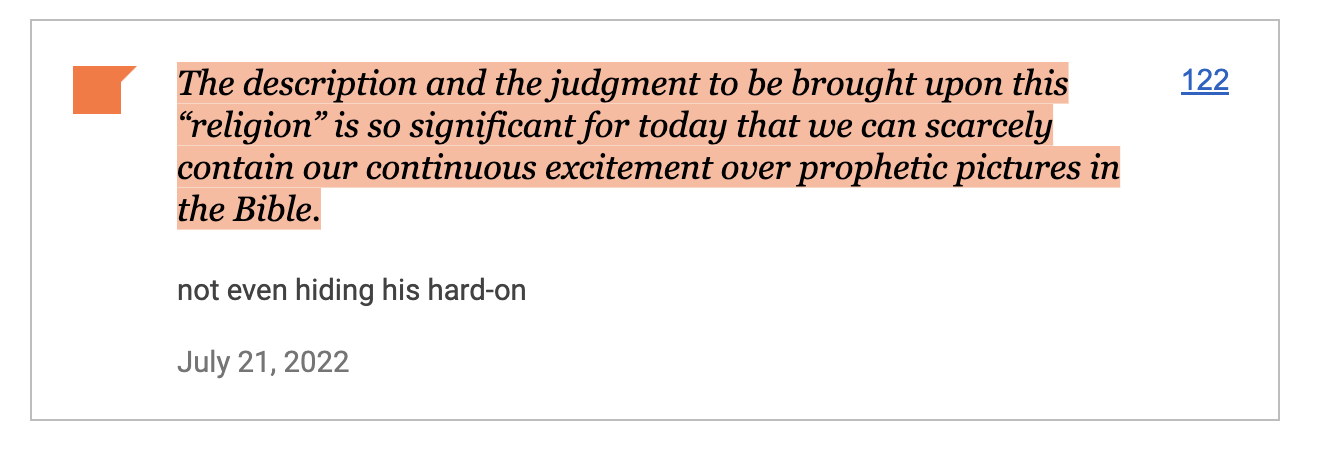
Authorship and audience
While I’m on the topic of male genitalia, this seems like as good as any place to, uh, raise this: I’m going to continue to refer to LGPE, the writing, and the hard-on as Lindsey’s, since that’s what everyone else does, but Lindsey actually hired Christian journalist and (holy) ghostwriter C. C. Carlson to help him with the project.
Unsurprisingly, it sounds like Carlson did a lot of the work, and did so without anyone knowing the first C was for Carole and that she was a woman.

That said, there were a number of popular fundamentalist Christian books published by women in the 1970s who didn’t disguise their gender identity, but many of them focus on the joy of submitting to earthly male authority, such as Marabel Morgan’s The Total Woman, which anyone I would want to be friends with would see as The Partial Woman.
Basham, the Kentucky history professor whose graduate thesis I referenced earlier, sees the sales of these books as being fuelled in part by a backlash against social changes of the era, such as advancements in feminism, like Roe vs. Wade in 1973, which—fuck.
Anyway, this is how Basham puts it:
Ironically, conservative Christian concern about feminist activity created a market for female Christian writers writing against feminism. 2
This backlash against feminism and a wide range of other perceived evils also powered some of the sales of LGPE.
Indeed, Lindsey provides a framework for conservatives to see social changes that disturb them as Biblically prophesied examples of worldly decline that would not just be reversed during the events of Revelation, but reversed over, again and again (figuratively speaking).
And then after the Last Judgement, anyone who had supported them would burn forever in their axolotl bodies (not figuratively speaking).

Interpreting the Bible
This kind of switching between literal and figurative interpretation without apparent cognitive dissonance in fact reflects how Lindsey reads the Bible in order to produce explanations and predictions that fit his beliefs. 3
As I alluded to when discussing the Reference Bible earlier, dispensationalists see the Bible as “inerrant” and “infallible.” This is what allows Reverend Turner to outline the forthcoming plot points to his various visitors in the A Thief in the Night series with such certainty.
Although this belief was by no means new at this point, it was formally codified in the 1978 “Chicago Statement on Biblical Inerrancy,” published in the Journal of the Evangelical Theological Society.
This paragraph provides the best summary of the document’s position:
- Being wholly and verbally God-given, Scripture is without error or fault in all its teaching, no less in what it states about God’s acts in creation, about the events of world history, and about its own literary origins under God, than in its witness to God’s saving grace in individual lives.
There are all sorts of questions that arise from that quotation alone, some of which the authors try to pre-empt in the rest of the document, but for once I am not going to pick at a thread and will leave it there as a juicy dangler.

Biblical literalism
If the Bible is factually true, dispensationalists agree that reading the text “literally” is the only appropriate way to interact with God’s words.
You can probably guess that I’m going to talk further about the word “literally” by the quotation marks I’ve placed around it, like an old lady picking up something nasty with a pair of tongs. 4
A “literal” approach, however, is not so much about reading the text without metaphor or allegory as much as it is a signal that someone subscribes to dispensationalist theology.
Indeed, Basham says “literalism” is mostly “a banner under which dispensationalists unite, much like the term ‘biblical inerrancy’” itself. 5

Drawing on Understanding Dispensationalists by theologian Vern S. Poythress, Basham identifies the four modes of “literal” Biblical interpretation, which are not really literal at all:
Poythress uses as an example Isaiah 27:2–6:
“Sing about a fruitful vineyard:
I, the Lord, watch over it;
I water it continually.
I guard it day and night
so that no one may harm it.
I am not angry.
If only there were briers and thorns confronting me!
I would march against them in battle;
I would set them all on fire.
Or else let them come to me for refuge;
let them make peace with me,
yes, let them make peace with me.”
In days to come Jacob will take root,
Israel will bud and blossom
and fill all the world with fruit.
1. First thought
Using this method, you interpret the text based on your “first thought” when you see a particular word or phrase, without considering context, which is close to blindly relying on the first dictionary definition. 6
Of course, this can get silly really fast—for instance, interpreting God saying “If only there were briers and thorns confronting me! / I would march against them in battle” as Him being ready to physically fight an army of shrubs, something like Day of the Triffids.

2. Flat interpretation
In this case, you read “obvious” allegory and metaphor figuratively but use first thought wherever possible. 7
This leaves a lot of room for judgment of where exactly something falls on the literal-to-figurative spectrum, and also how you approach figurative language.
Using flat interpretation, you would read battling the army of thorny bushes as an obvious metaphor for rising to any kind of challenge, but the vineyard as just a vineyard—even though the last few lines can be interpreted as an obvious metaphor about the spiritual growth of the people of Israel and the spread of their religion.
3. Grammatical-historical
In grammatical-historical interpretation, you take into account the authorship of that particular section of the Bible and the historical conditions under which it was written. 8
This makes sense, but of course, the authorship and what those historical conditions were is also a matter of your own contemporary perspective as well.
Poythress doesn’t provide an example here and I don’t know anything about the historical context of Isaiah. But a similar example in Revelation would be the common historical reading that the whole thing is just a Tarantino-esque revenge fantasy against the Romans.
4. Plain
In the final method, you rely on your own contemporary perspective and ignore the conditions under which the text was written. Although Lindsey uses all four tactics, this seems to be his preferred approach, and it’s where things naturally get the most bonkers. 9
As well as being the easiest to get loose with, it is also inherently unstable. As the modern world changes, the meaning of the Biblical text therefore also changes, since previous explanations stop working. 10
For example, to many dispensationalists in the late 1980s, the Book of Revelation was really talking about Mikhail Gorbachev’s port-wine stain birthmark when he described the Beast’s head wound…until Gorbachev left power and the USSR disintegrated and he didn’t turn out to be the Beast and then the Bible was talking about someone else and Oceania had always been at war with Eastasia.

(Also, if that weren’t enough, Gorbachev just died and didn’t come back to life after.)
As is probably clear by now, Basham concludes that gathering these four tactics under the label of “literal interpretation” gives the interpreter license to read the Bible however fits their own beliefs:
the broad concept of “literal” allows for malleability when explaining the meaning of text and for easy shifting from first thought to flat to plain interpretation in order to shape the text to fit a given position. 11

This is exactly what Lindsey does, when he claims that John in his island cave in the first century AD foresaw events that were going to happen in the late twentieth century.
Where reading Revelation “literally” doesn’t get Lindsey where he wants to go, he switches gears, saying, for instance, that when he talks about a burning mountain falling into the sea, John just didn’t have the vocabulary or conceptual framework to describe an ICBM strike, or that the same went for the locusts, which actually represent—you’ve got it—helicopters.

I’m not actually sure if Lindsey was the first to make the locust/helicopter connection but he certainly influenced a lot of people with it.
God’s role
It’s worth highlighting that, as well as the signs of the End Times, Lindsey also gets into some specific prophesies by the end of the book—but he doesn’t claim that God is talking to him directly like the prophets of the Old Testament.
It’s pretty well accepted by all the faiths that rely on the Old Testament that God stopped appearing to humans, let alone speaking to us, by the end of the period covered by the text. And for dispensationalists, it’s not until 1007 years into the events of Revelation that He’s going to make an appearance again.
Lindsey does, however, mention this verse from Amos 3, which he takes from the Amplified Bible:
Surely the Lord God will do nothing without revealing His secret to His Servants the prophets.
For anyone wondering, the Amplified Bible is not hundreds of hours of Christian rock music produced by any element of Crü, motley or otherwise, but a Bible edition that was released by Lindsey’s publisher, Zondervan, in 1965—who I also just learned currently owns the rights to the Berenstain Bears franchise.
Lindsey quotes from that edition the most heavily, but, in line with his strategy throughout, he also seems to switch versions wherever it suits him.
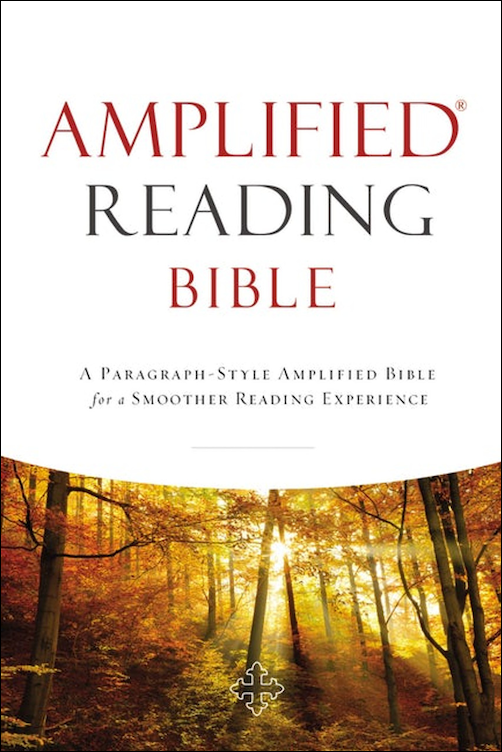
Relevant to the earlier discussion of Biblical interpretation, like the Reference Bible, The Amplified Bible includes a bunch of annotations.
Some come in the form of footnotes, but many are placed inline throughout. For instance, Revelation 20:12, which concerns the Final Judgement, appears in the Amplified Bible like this:
I [also] saw the dead, great and small; they stood before the throne, and books were opened. Then another book was opened, which is [the Book] of Life. And the dead were judged (sentenced) by what they had done [their whole way of feeling and acting, their aims and endeavors] in accordance with what was recorded in the books.
That’s reminiscent of Buck’s hardline pitch to Chris, Rayford’s copilot, in Tribulation Force, in which he says that Chris’s adulterous thoughts alone would consign him to the flames.
But just a “way of feeling”—that takes it even further. And saying that “sentenced” is the actual meaning of “judged” makes it sound like the outcome of the trial is a foregone conclusion. Which I guess is not wrong.
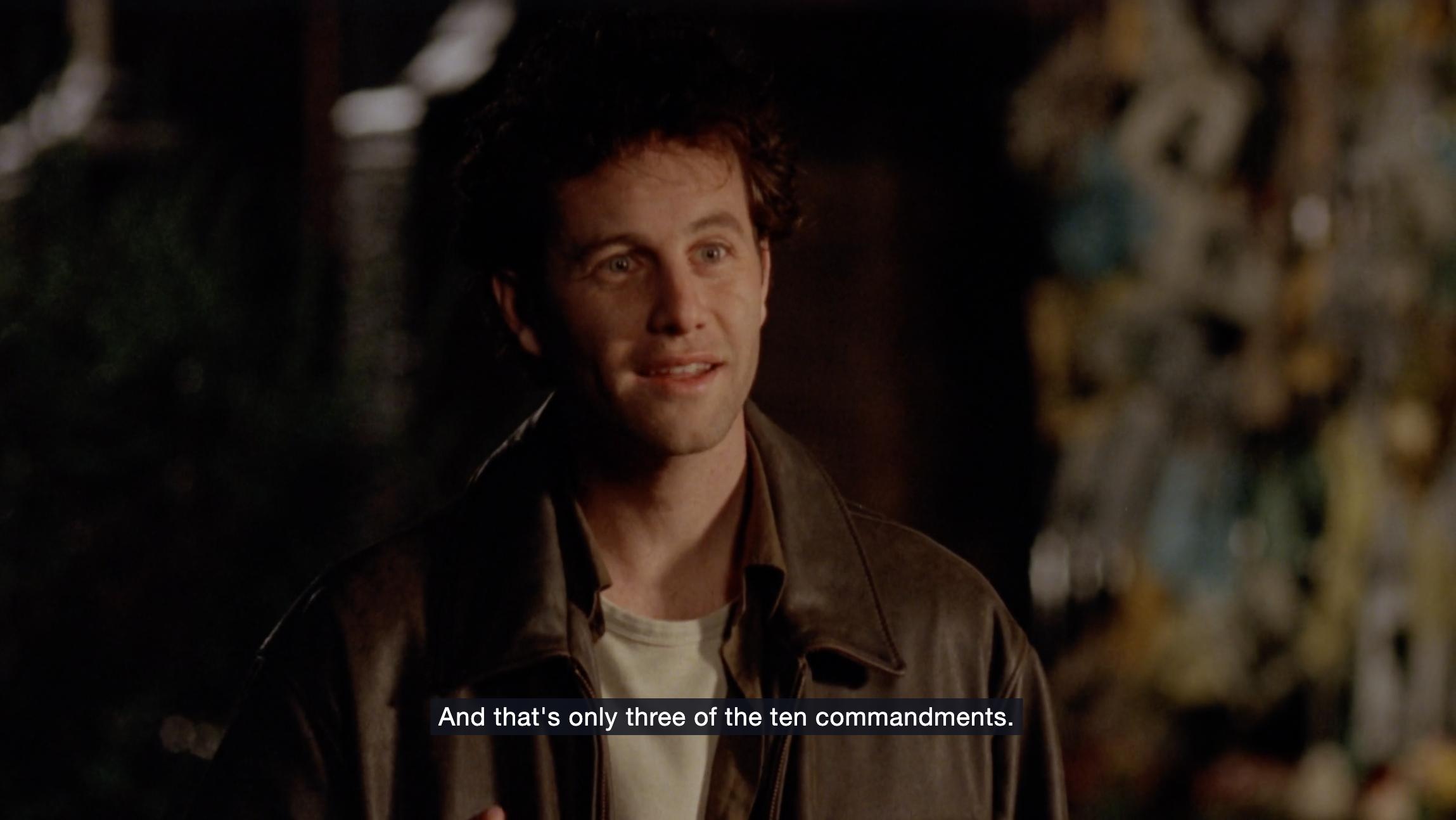
Lindsey takes from Amos (and all the annotations) that even if God hasn’t been around much lately, He will still disclose any material developments in advance to believers, as if he were subject to SEC regulations.
And how better to do that than by gifting Harold Lee Lindsey with the ability to piece His plans together from what are ostensibly His words from over two thousand years ago, as dictated to other people, and translated through several languages?
At any rate, Lindsey says,
when God is going to undertake some significant movement of history as far as His program is concerned, He will reveal it first. This writer doesn’t believe that we have prophets today who are getting direct revelations from God, but we do have prophets today who are being given special insight into the prophetic word. God is opening the book of the prophets to many men. 12
And “this writer” is one of those men with special insight into the prophetic word. How fortunate!
Lindsey’s later life
It feels a little jarring to jump directly from saying that Lindsey claimed special insight into the future to what he’s been doing since revealing those insights, but as I said before, his work forms the backbone of the material on signs and predictions that will make up Sections 3-6. So we’ll get to it soon, and you can look forward to a lot more of Lindsey’s own “hip” language.
So I’ll conclude what I originally intended to be a short introduction to Lindsey and LGPE (😅) with some notes on what he’s been up to since 1970.
Lindsey next published There’s A New World Coming in 1973, which focused on the events of Revelation that we are familiar with and which was adapted into the comic that I’ve shared throughout.
But it didn’t sell nearly as well, and nothing else he ever wrote matched the sales or impact of LGPE, not even 1994’s Planet Earth: 2000 A.D.

Even if popular success to the same degree eluded him, Lindsey actually gained even more influence in the 1980s through his relationship with the Reagan administration, which I’ll talk about more when I look at Ronald Reagan in Section 2, which is about American politics and foreign policy. I will drop a few details here, however.
David S. New shares a fittingly bizarre story of one factor that led to Lindsey’s political and military influence in his 2002 book Holy War: The Rise of Militant Christian, Jewish and Islamic Fundamentalism:
Lindsey’s role as ambassador-at-large for military apocalypticism had gotten started several years earlier when a prominent attorney active in the government of Jamaica had distributed 1,500 copies of The Late Great Planet Earth to select friends and government officials. They were so impressed that they wanted Lindsey to come to Jamaica “to tell them what they should do next.” 13
And, because I can’t go more than a few minutes without mentioning the US Air Force:
Soon Lindsey was invited to speak to the American Air War College, an Air Force school that teaches air warfare strategy to military commanders. Attendance was voluntary, but virtually the whole school turned out, including many of the officers’ wives. Lindsey’s topic? The military aspects of biblical prophecy with reference to the Middle East and World War III. The audience responded “with an enthusiastic ovation.” 14

Lindsey’s involvement got even more frightening from there. But again, I’ll get to that next time.
Digression time. I wanted to see if there was any explicitly religious symbolism in the Air War College emblem above, maybe in the lamp or the Starfleet-esque figure in the middle.
I couldn’t find that particular crest on the official US military heraldry website, which is a hot mess, but I did determine that type of lamp and book usually represent learning. In fact, the crest of Toronto Metropolitan University, formerly X University, formerly Ryerson, features the same kind of lamp.
The “delta” figure in the middle of the Air War College emblem was first used by the USAF in the 1940s but I couldn’t figure out what the reasoning was then, just that over the last 80 years it’s also become associated with the delta-shaped wings on many American air and space vehicles.
And US Strategic Command, which is currently responsible for US nuclear weapons, says that the lightning bolts on its own emblem represent “lethality and speed”:

But although the STRATCOM site doesn’t mention it, lightning bolts in medieval heraldry also represent “fire from heaven,” so there’s that.
You may have thought because of the presence of what I just learned right now is called a “dinkus” that the digression was over, but no!
I’m actually going to digress from the digression—but only because it loops back around like a bomber group coming back for a second run over the target.
While looking for information about the emblem for Strategic Air Command, which was responsible for the Air Force’s portion of American nuclear weapons before the creation of Strategic Command, I came across the emblem for another organization that goes by the same initials. In this case, SAC stands for Strategic Angel Care:

For comparison, this is the emblem of the original SAC:

Strategic Angel Care describes itself like this:
In 2002, John Neese founded a ministry to orphans and hurting children of the former Soviet Union. He named it “Strategic Angel Care (SAC)” to remember the history and connection of his former duties as an ICBM launch officer during the Cold War and his higher calling to a spiritual battle in the age of the church.
SAC’s “Expanded Statement of Faith” is, unsurprisingly, entirely consistent with dispensationalism. It also has a lot to say about abortion and gender identity.
It is just as against the prosperity gospel, however, which is an ideology some evangelical churches and particularly big-name televangelists subscribe to, where if believers give money to “God,” who has tax-exempt status, they are told God will reward them with material success in this life. I am actually with SAC in dunking on that, for obvious reasons.
Anyway, whipping out another dinkus so we can finally get back to Hal Lindsey.
Starting in the 1970s, Lindsey regularly appeared on television via the popular Christian Trinity Broadcasting Network, but in 2005 his show was taken off the air because his rhetoric had reached a level of anti-Muslim hate that crossed a line for its founder, Paul Crouch, who said at the time:
I am not aware of a single instance where making inflammatory, derogatory anti-Muslim statements has led a single follower of Islam to Christ. 15
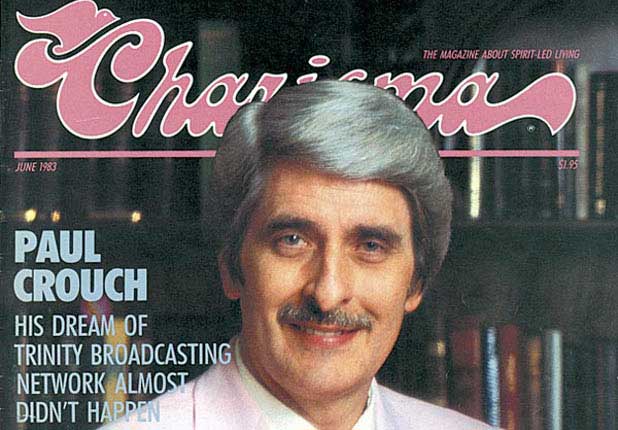
Lindsey was given the opportunity to modify his approach rather than lose his show, but needless to say, he did not, and here’s an excerpt from his letter in response to Crouch:
Jesus confronted false religion (which Islam is) by calling them “whitewashed tombstones”, “Brood of vipers”, and “sons of hell” in Matthew 23.
And another:
I am sure of my calling from the LORD. One important part of that calling is to sound a prophetic alarm to America and the world about the dangers of the false religion of Fundamental Islam. It is a “Watchman on the Wall” kind of calling.
But two years later, once TBN found a technical solution to prevent Lindsey’s program from airing in majority Muslim countries in the Middle East, the network invited him back.
As Basham puts it, this let Lindsey “warn the world about the Muslim threat without offending actual Muslims abroad,” which sounds like galaxy brain startup thinking. 16
Despite having free rein to spew hate again, Lindsey did, at some point between the completion of Basham’s thesis in 2012 and the present, decide to leave TBN.
Now, at age 92, as the “Watchman on the Wall” he referenced in the letter, Lindsey posts news stories that support his predictions along with half-hour weekly videos with titles like “John Part 77” on his website, which just crashed my browser.

Lindsey’s videos stream from a white-label-ish service called JW Platform with the player embedded on his website, rather than using a service that would show views, comments, and likes, such as YouTube or, if Lindsey still has things to say about Muslims, Rumble. All of which is just to say that I really have no idea who watches the Watchman.
Rapture Ready
I was, however, able to determine how many people visit Rapture Ready, a dispensationalist prophecy tracker site, at least according to the founder Todd Strandberg: a quarter of a million unique visitors per month.
Strandberg says he’s a dinosaur—which, uh, never mind—who only knows HTML, but his site is loading a bunch of code from Google Analytics, so maybe that number is as accurate as any other web analytics metric. It doesn’t seem possible that 50–300 million people have seen A Thief in the Night either, but that number is apparently accurate as well.
Strandberg started Rapture Ready in 1987 on Usenet, a sort of pre-World Wide Web bulletin board, and turned it into a website in the mid nineties. If you’re curious, this is the first capture of the site on archive.org, from August 23, 2000 (thanks again to Matt for the tip).
At any rate, for the last 35 years, Strandberg has been devoted to keeping track of signs of the End Times in a programmatic format seemingly inspired by the Bulletin of the Atomic Scientists’ Doomsday Clock. Here’s the main graphic from the home page:
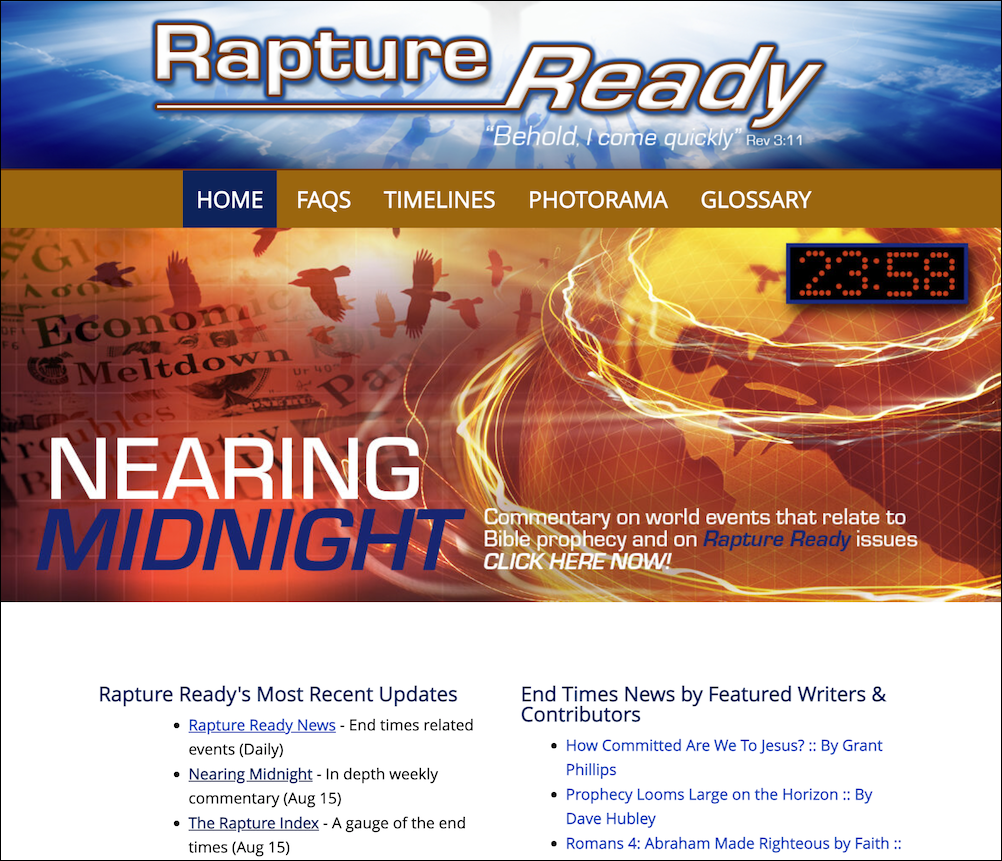
Strandberg and his influences
I learned about Rapture Ready from a recent Washington Post article, but the first piece I came across when I started looking into it was from Wired all the way back in 1996.
It mentions that at that time, Strandberg was a member of—guess what?—the US Air Force, a sergeant stationed at Offutt Air Force base near Omaha, Nebraska.
Before 1992, Offutt was where Strategic Air Command, which I just mentioned, was headquartered.
The original motto of the US Strategic Air Command (from 1946-57) was "War is our profession—Peace is our product." pic.twitter.com/mhfYKicJNR— Stephen Schwartz (@AtomicAnalyst) February 12, 2015
And since the reorganization that year, it has been the location of US Strategic Command, which, as I also mentioned before, is responsible for overseeing US nuclear strike capability across all branches of the military, and is also apparently subject to the same issues as every other employer as workers got used to working remotely during the pandemic:
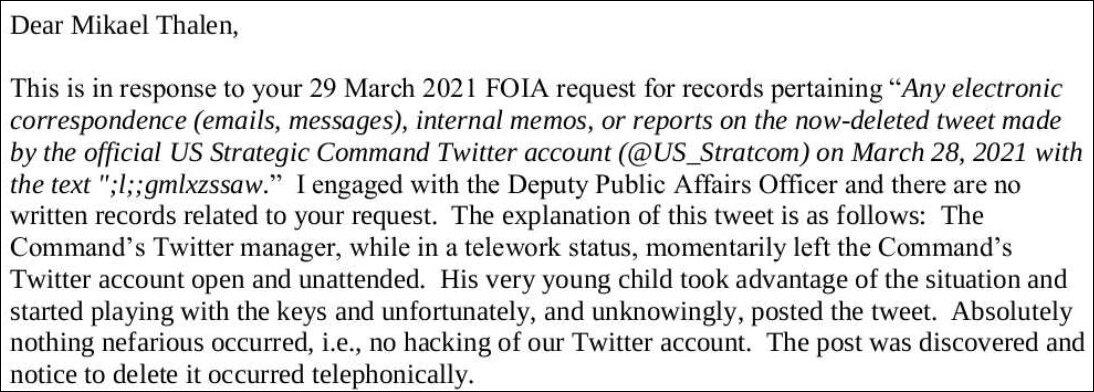
Speaking of children, according to Wired, Strandberg got into prophecy well before he joined the Air Force—at age fifteen.
In the same five-year-old video interview at sermons.love where he mentions his unique visitor count, Strandberg discloses how he got started:
I got reading Hal Lindsey’s book, The Late Great Planet Earth […] It was the best seller of the 1970s. It really started the great End Time prophetic movement […] And I think what really appealed to me is the fact that it took Bible prophecy and current events and melded them together and people could see that we are in the last days.
Here he is answering that question:

The Rapture Index
Rapture Ready describes the index like this:
The Rapture Index has two functions: one is to factor together a number of related end time components into a cohesive indicator, and the other is to standardize those components to eliminate the wide variance that currently exists with prophecy reporting.
You could say the Rapture Index is a Dow Jones Industrial Average of end time activity, but I think it would be better if you viewed it as prophetic speedometer. The higher the number, the faster we’re moving towards the occurrence of pre-tribulation rapture.
100 and Below: Slow prophetic activity
100 to 130: Moderate prophetic activity
130 to 160: Heavy prophetic activity
Above 160: Fasten your seat belts
I’ll share what these “end time components” are and what one day’s values for them are in Sections 3-6, when I talk about signs, so they make more sense when you see them, but, for now, there are 45 categories and each is assigned a value that changes every day. Adding them up gives us that day’s Rapture Index:
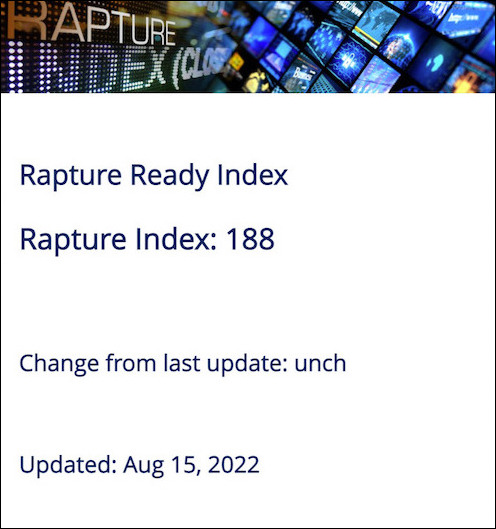
Strandberg also leaves brief comments about any “active categories.” I’ll share just this one example because I already touched on it in discussing Lindsay’s position on drug use:
Satanism: The lack of activity has downgraded this category.
👿 📉
These are the all-time records:
All-Time High: 189 (October 10, 2016)
All-Time Low: 58 (December 12, 1993)
I haven’t looked into what happened on those dates yet, but that reminds me I did also find this quote from Newsweek in 2008:
According to Strandberg, any number over 160 means “fasten your seat belts.” Obama’s win pushed the index to 161.
Other material
As well as the index itself, the site features a number of other sections. These include daily news round-ups that link to articles from even less trustworthy sources than Lindsey’s, as well as Strandberg’s own weekly analysis, and articles by other contributors.
There is also an extensive FAQ (the questions total 7000 words) that is organized by the topics below:
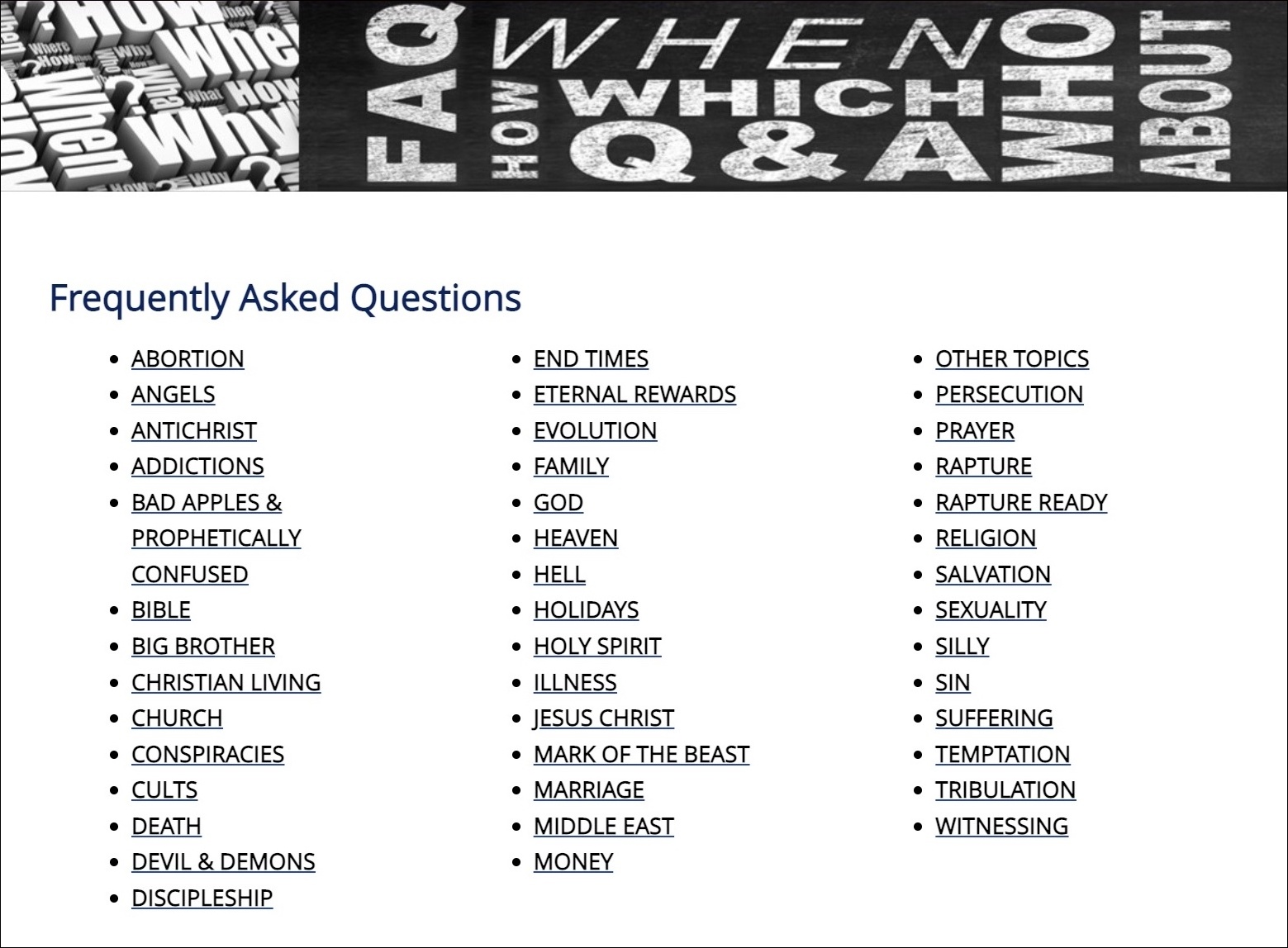
There is even a guide for those left behind:

Strandberg also co-wrote a book with the other guest in that interview, dispensationalist author Terry James, who had both served in the US Air Force and also died, seen heaven, and come back, three times in one day.
Are You Rapture Ready? was published by an imprint of Penguin in 2003, and the foreword is even by Tim LaHaye, so it’s not a nothingburger, which is a term I only learned while working on this post and I just wanted to use it.
Immanentizing the Eschaton
The 1996 Wired article ends on this memorable note:
Strandberg […] doesn’t give a tinker’s damn when the Eschaton is immanenitized, or who will be to blame. As he sees it, our planet functions solely as “eternity’s airport terminal. Life on Earth serves a purpose, but only in getting us to our final destination.”
The Eschaton is another name for the End Times, which is straightforward enough. It is also the name of a nuclear war simulation game played by children with tennis rackets and balls in David Foster Wallace’s 1996 novel Infinite Jest, which I think is where I first saw the term.
“Immanentizing the Eschaton,” however, is a term I hadn’t heard of before, but it ends up tying back into several topics I’ve already explored during this post.
My first thought was that the term was being used literally, in the sense that combining those two words would mean “to make imminent the end of the world.” I’m almost certain that’s how it was intended.
That’s how it seems to be used in this image, which was part of a 2005 photo shoot for a defunct website called The Toilet that is still circulating around the Internet:

But there’s also a whole grammatical-historical context around the way that the term developed, according to Lexico, which stopped existing while I was writing this post. Thank goodness for archive.org.
Anyway, I’ll take an Amplified Bible approach and dump even more material into their definition:
Immanentize the Eschaton
To attempt to bring about utopian conditions in the world; to seek to create heaven on earth. Frequently in negative contexts, as “don’t immanentize the eschaton”.
Apparently coined [in the 1960s] by [the influential American arch-conservative] William F. Buckley[, who was, however, Catholic, not evangelical,] with allusion to the [1950s] writings of [anti-communist German-American philosopher] Eric Voegelin.
The phrase is commonly used depreciatively by conservative critics of progressive or utopian political ideologies, as communism, socialism, etc.
So, as reported by Lexico, “Don’t immanentize the eschaton” is often deployed not to mean “don’t try to force the End Times by pushing for nuclear war in the Middle East,” but something closer to its exact opposite: “Only God can create a perfect world, so don’t try to make life better for everyone else.”
Both meanings line up nicely, however, with the topic I’m going to cover next time, in Part VII Section 2: connections between dispensationalism and US politics and foreign policy.
Although there are way more links than just those involving three specific presidents, I’m going to focus on the presidencies of Ronald Reagan, George W. Bush, and Donald Trump as examples of larger currents that continue to run through more liberal administrations.
Then in Sections 3–6 I’m going to talk about signs, predictions, and responses, drawing on the sources I’ve introduced in the first two sections. And finally Section 7 is where I will try to wrap things up.
But first, to close this post off with a musical number, as usual, I’m going to go with “Calamity Song” by the Decemberists, which pretty faithfully portrays the eschaton game scene from Infinite Jest. I think that’s the closest we’ll ever get to a screen adaptation of the novel, which is 1100 pages long, 100 of which are endnotes (this is my favourite one) in very small text.
References
-
Cortney S. Basham, “Hal Lindsey’s The Late, Great Planet Earth and the Rise of Popular Premillennialism in the 1970s,” MA diss., (University of Western Kentucky, 2012), https://digitalcommons.wku.edu/theses/1205, 14. ↩
-
Basham, 6. ↩
-
Basham, 55. ↩
-
I stole that line from somewhere but I couldn’t find where it originally came from. I imagine a funny British writer like Douglas Adams or Terry Pratchett. The only Google results were not one but two people also ripping it off in UK-focused alternate history scenarios they had posted to the same forum. ↩
-
Basham, 46. ↩
-
Basham, 44. ↩
-
Basham, 45. ↩
-
Basham, 46. ↩
-
Basham, 46. ↩
-
Basham, 46. ↩
-
Basham, 47. ↩
-
Hal Lindsey, The Late Great Planet Earth (Grand Rapids: Zondervan, 1970), near the start of Chapter 8. E-books are hard to cite! ↩
-
David S. New, Holy War: The Rise of Militant Christian, Jewish and Islamic Fundamentalism (Jefferson: McFarland, Incorporated, Publishers, 2002), 75. ↩
-
New, 75. ↩
-
Basham, 65. ↩
-
Basham, 65. ↩
Subscribe to The Golden Age of Apocalypse
Get the latest posts delivered right to your inbox
